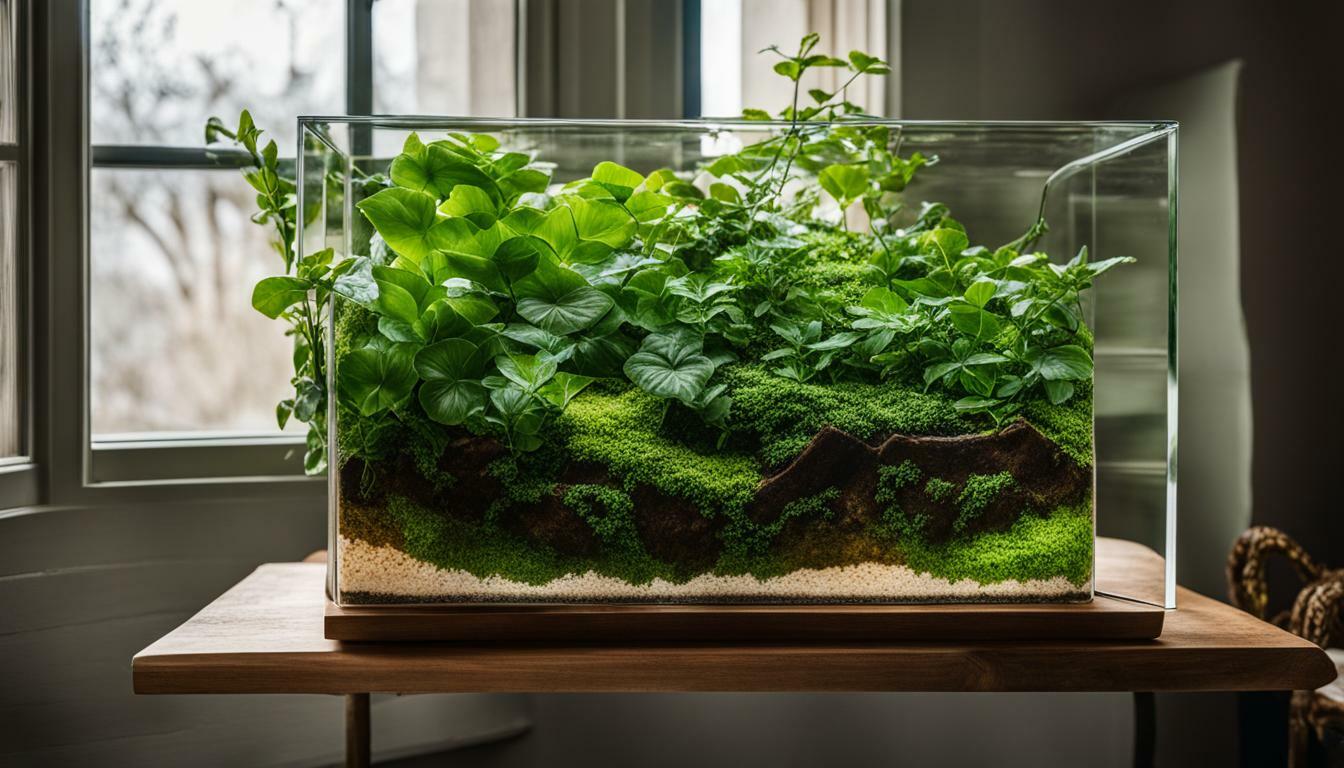- Creeping fig is a popular terrarium plant with a stunning appearance.
- It is native to Asia and is known for its vining growth habit.
- Creeping fig requires warm, humid air, bright indirect light, and regular watering.
- Regular pruning and repotting are essential to keep creeping fig in check.
- It can be propagated through stem cuttings and is susceptible to common pests.
Exploring Terrarium Plants: Creeping Fig’s Growth Habits
Creeping fig, also known as Ficus pumila, is a perfect choice for miniature terrariums and those looking for low maintenance plant options. This vining plant features small heart-shaped glossy leaves that cascade over the sides of the pot, creating a lush and visually appealing display. Native to Asia, creeping fig is relatively hardy and can adapt to a variety of growing conditions, making it an excellent choice for beginners in terrarium gardening.
With the right care, creeping fig can grow up to 15 feet in length, making it an ideal plant for creating vertical interest in your terrarium. It is important to provide the plant with warm, humid air and bright indirect light, as it thrives in tropical environments. Regular watering is essential to keep the soil moist but not waterlogged, as excessive moisture can lead to root rot.
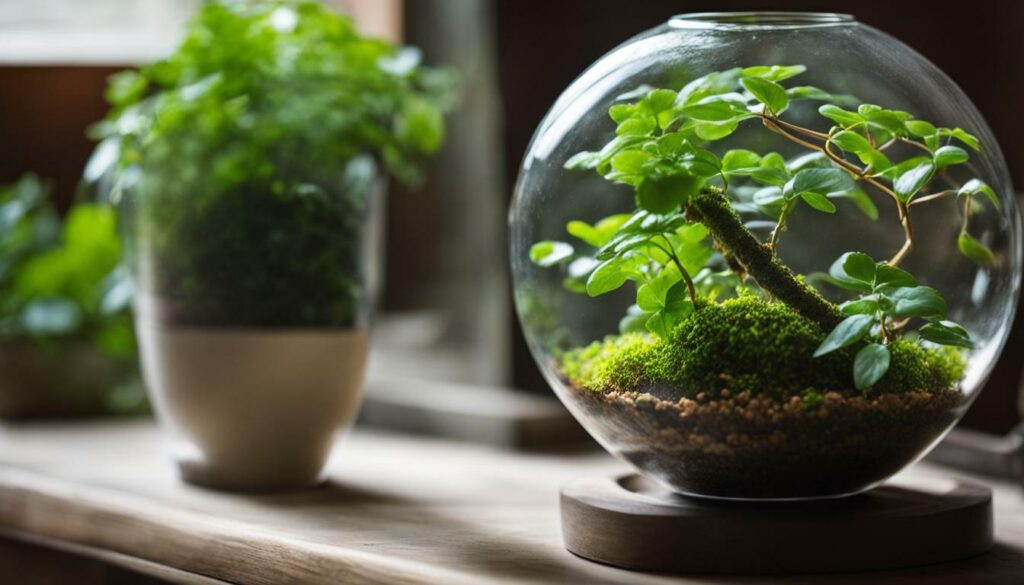
One of the key advantages of using creeping fig in your terrarium is its low maintenance nature. This plant requires minimal pruning and can tolerate periods of neglect. However, it is recommended to prune the plant regularly to prevent it from becoming invasive or overcrowding your terrarium. To ensure its proper growth, repotting the creeping fig annually is also crucial, giving it fresh soil and space to thrive.
While creeping fig is a hardy plant, it is not immune to pests. Aphids, mealybugs, scale, and whitefly can infest the plant, causing damage to its leaves. Regularly inspecting your terrarium and treating any infestations promptly will help keep your creeping fig healthy and vibrant. Overall, with its attractive appearance and minimal care requirements, creeping fig is an excellent choice for terrarium enthusiasts seeking a beautiful and low maintenance plant.
Care Guide for Terrarium Plants: Creeping Fig
To ensure the health and vibrancy of your creeping fig in a terrarium, it’s important to understand its care needs, especially if you’re a beginner or considering it as part of a tropical-themed terrarium. Native to Asia, creeping fig (Ficus pumila) is a popular choice for terrariums and indoor pots due to its attractive appearance and relatively easy care requirements.
When it comes to light, creeping fig thrives in bright indirect sunlight. Place your terrarium in a location that receives bright, filtered light, away from direct sunlight which can scorch its delicate leaves. If you’re unable to provide sufficient natural light, you can supplement with artificial grow lights to ensure optimal growth.
Tropical in nature, creeping fig requires warm, humid conditions. Maintain a temperature range of approximately 65-75°F (18-24°C) and humidity levels between 50-70%. You can increase humidity by misting the plant with water or placing a tray of water near the terrarium to create a humid microclimate.
When it comes to watering, it’s important to strike a balance. Over-watering can lead to root rot, while under-watering can cause the plant to dry out. Aim to keep the soil evenly moist, but not saturated. Water thoroughly and allow the top few inches of soil to dry out before watering again. It’s also worth noting that creeping fig is sensitive to chemicals found in tap water, so it’s advisable to use filtered or distilled water for watering.
| Facts at a Glance | |
|---|---|
| Growth Habit | Vining |
| Light Requirements | Bright indirect light |
| Temperature | 65-75°F (18-24°C) |
| Humidity | 50-70% |
| Watering | Keep soil evenly moist, not saturated |
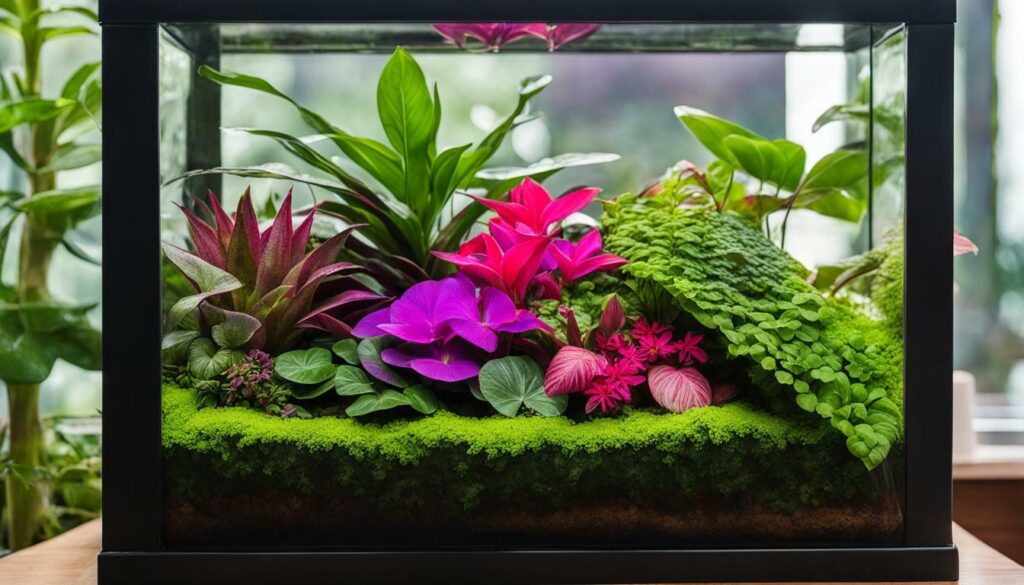
“Creeping fig is a stunning addition to any terrarium, with its cascading foliage and easy-going nature. Just be sure to provide it with the right conditions, and it will reward you with its lush greenery.”
Regular pruning is essential to keep your creeping fig in check and encourage bushier growth. Trim back any excessive growth to maintain the desired shape and prevent it from becoming unruly. You can use sharp pruning shears or scissors to remove unwanted branches or stems. As a general rule, it’s advisable to prune your creeping fig every few months or as needed.
If you’re planning to propagate your creeping fig, stem cuttings are the way to go. Simply cut a healthy stem with a few leaves attached, remove the lower leaves, and place the cutting in a container with moist soil. Keep it in a warm, humid environment and mist it regularly to promote root growth. Within a few weeks, you should start to see roots forming, indicating successful propagation.
With its attractive foliage and low maintenance requirements, creeping fig is an excellent choice for terrarium enthusiasts, especially beginners. By providing the right conditions and following these care guidelines, you can enjoy the beauty of a thriving creeping fig in your terrarium, adding a touch of tropical charm to your indoor space.
The Aesthetic Charm of Terrarium Plants: Creeping Fig
With its cascading foliage and the ability to thrive in hanging terrariums, creeping fig can add a touch of natural beauty and elegance to any indoor space. The luscious green leaves of this plant create a stunning visual display, resembling a lush living curtain that gracefully drapes down from its container. Whether placed in a living room, bedroom, or even a bathroom, the hanging tendrils of creeping fig can instantly breathe life into any area. Aside from its captivating appearance, creeping fig is also a convenient choice for those looking to decorate their homes with terrarium plants. Its compact nature allows it to fit perfectly in hanging terrariums, making it an excellent choice for smaller spaces or those with limited surface area. Unlike other plants that may require constant attention and care, creeping fig is relatively low maintenance, allowing even the most novice of plant owners to enjoy its beauty without the hassle. If you’re considering adding creeping fig to your collection of terrarium plants, you’ll be delighted to know that it is readily available for purchase online. This accessibility makes it convenient for plant enthusiasts to find and order this lovely addition to their indoor oasis. Whether you’re a seasoned plant lover or just starting to explore the world of terrariums, hanging terrarium plants like creeping fig can be the perfect addition to your home, adding a touch of nature’s charm and creating a serene environment that you can enjoy year-round.In the words of Henry David Thoreau, “I went to the woods because I wished to live deliberately, to front only the essential facts of life, and see if I could not learn what it had to teach, and not, when I came to die, discover that I had not lived.” With hanging terrarium plants like creeping fig, you can bring a piece of nature’s beauty into your everyday life, allowing you to appreciate the simplicity and serenity found in the natural world.
Terrarium Plants Online: Find Your Perfect Creeping Fig
For those who are unable to visit physical plant nurseries or prefer the convenience of online shopping, there are numerous online platforms where you can find and purchase creeping fig. These specialized online stores offer a wide variety of terrarium plants, including hanging options like creeping fig, allowing you to explore and choose the perfect addition to your indoor space. With just a few clicks, you can have a beautiful creeping fig plant delivered right to your doorstep, ready to enhance your terrarium or hanging display. To summarize, the aesthetic charm of creeping fig in terrariums is undeniable. Its cascading foliage, ability to thrive in hanging terrariums, and low maintenance nature make it a popular choice among plant enthusiasts. With the convenience of terrarium plants online, you can easily find and bring this natural beauty into your home. So why wait? Start creating your own miniature green oasis today with the enchanting creeping fig.Tips for Maintaining Terrarium Plants: Creeping Fig
Proper maintenance is key to ensuring the long-term growth and vitality of your creeping fig in a terrarium, especially if you have a small terrarium or desire a tropical ambiance. Here are some essential tips to help you keep your creeping fig thriving:
- Provide the right lighting: Creeping fig plants require bright indirect light to grow well. Place your terrarium in a location where it can receive sufficient natural light, but avoid direct sunlight as it can scorch the leaves.
- Monitor humidity levels: Keep the terrarium environment humid by misting the plant regularly or using a humidity tray. This is crucial, especially if you have a tropical-themed terrarium, as creeping figs thrive in high humidity.
- Watering: Water your creeping fig in moderation, allowing the top inch of soil to dry between waterings. Overwatering can lead to root rot, so it’s important to strike a balance and avoid waterlogged soil.
- Regular pruning: Trim back any overgrown or leggy branches to maintain the desired shape and size of your creeping fig. This will help promote healthier growth and prevent the plant from becoming unruly.
Preventing Pest Infestations
Creeping figs are susceptible to pests such as aphids, mealybugs, scale, and whitefly. To keep your plant pest-free, regularly inspect both the leaves and stems for any signs of infestation. If you spot any pests, remove them manually or use organic insecticidal soap to control the problem.
| Pest | Signs of Infestation | Treatment |
|---|---|---|
| Aphids | Visible small green or black insects on leaves | Remove by hand or use insecticidal soap |
| Mealybugs | White, cotton-like clusters on leaves and stems | Remove by hand or use insecticidal soap |
| Scale | Small, oval-shaped insects that attach to stems | Remove by hand or use insecticidal soap |
| Whitefly | Small, white insects that fly off when disturbed | Remove by hand or use insecticidal soap |
By following these maintenance tips and staying vigilant against pests, your creeping fig will continue to be a stunning addition to your terrarium. Enjoy the beauty of this small terrarium plant and the tropical ambiance it brings to your indoor space!
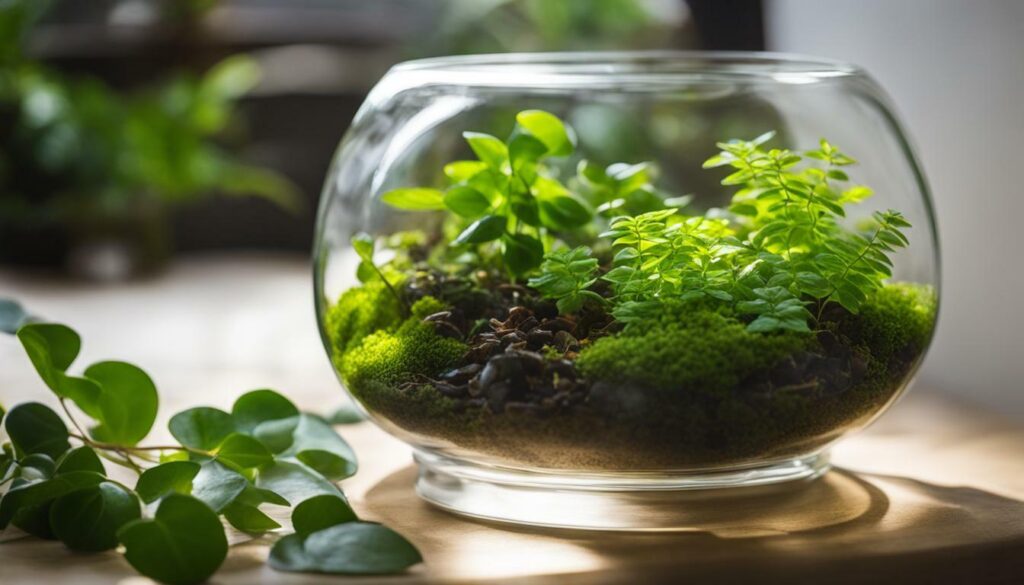
While creeping fig can be a stunning addition to your indoor terrarium, it’s important to understand its potential to become invasive if grown outdoors within its recognized hardiness range. Native to Asia, where it is commonly found climbing walls and trees, creeping fig has a vigorous growth habit that allows it to quickly cover large areas. This can be problematic when planted in the ground, as it can damage structures and overtake other plants in its path.
To control the invasiveness of creeping fig, it is recommended to keep it confined to pots or hanging baskets. By growing it in a controlled environment, such as a terrarium or indoor pot, you can enjoy its beauty without the worry of it spreading uncontrollably in your garden. Regular pruning is also essential to keep the plant’s growth in check. Trim back any excessive growth and remove any tendrils that may be reaching out towards nearby surfaces.
Additionally, it’s important to be aware of the potential for creeping fig to escape from outdoor pots and invade nearby areas. To prevent this, ensure that the pot or basket has adequate drainage to prevent water accumulation, as excess water can weaken the roots and make it easier for the plant to escape. If you do choose to grow creeping fig in an outdoor pot, regularly inspect the surroundings for any signs of root penetration or creeping fig spreading beyond the pot boundaries.
By understanding the potential invasiveness of creeping fig and taking appropriate control measures, you can enjoy this beautiful terrarium plant without worrying about its spreading tendencies. Keep it contained in a pot or basket, prune regularly, and be mindful of any signs of escape. With proper care, creeping fig can thrive as a stunning addition to your indoor space.
| Potential Invasiveness and Control of Terrarium Plants: Creeping Fig |
|---|
| Creeping fig can become invasive if grown outdoors in its hardiness range |
| Confine creeping fig to pots or hanging baskets |
| Regular pruning to control growth |
| Ensure pots have adequate drainage |
| Inspect surroundings for signs of escape |
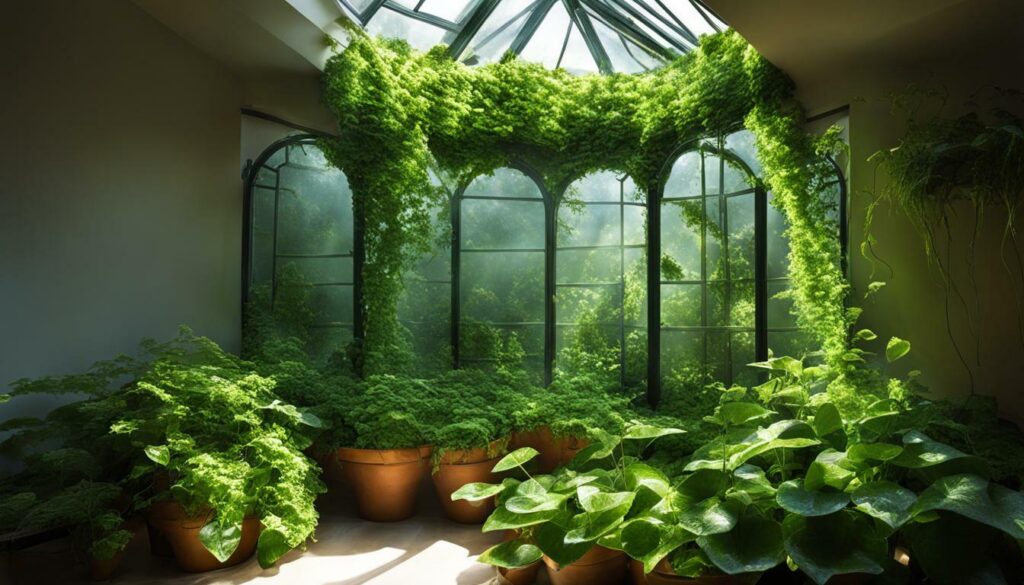
While creeping fig can be a stunning addition to your indoor terrarium, it’s important to understand its potential to become invasive if grown outdoors within its recognized hardiness range. Native to Asia, where it is commonly found climbing walls and trees, creeping fig has a vigorous growth habit that allows it to quickly cover large areas. This can be problematic when planted in the ground, as it can damage structures and overtake other plants in its path.
To control the invasiveness of creeping fig, it is recommended to keep it confined to pots or hanging baskets. By growing it in a controlled environment, such as a terrarium or indoor pot, you can enjoy its beauty without the worry of it spreading uncontrollably in your garden. Regular pruning is also essential to keep the plant’s growth in check. Trim back any excessive growth and remove any tendrils that may be reaching out towards nearby surfaces.
Additionally, it’s important to be aware of the potential for creeping fig to escape from outdoor pots and invade nearby areas. To prevent this, ensure that the pot or basket has adequate drainage to prevent water accumulation, as excess water can weaken the roots and make it easier for the plant to escape. If you do choose to grow creeping fig in an outdoor pot, regularly inspect the surroundings for any signs of root penetration or creeping fig spreading beyond the pot boundaries.
By understanding the potential invasiveness of creeping fig and taking appropriate control measures, you can enjoy this beautiful terrarium plant without worrying about its spreading tendencies. Keep it contained in a pot or basket, prune regularly, and be mindful of any signs of escape. With proper care, creeping fig can thrive as a stunning addition to your indoor space.
Propagation of Terrarium Plants: Creeping Fig
Want to expand your collection of creeping fig plants? Learn how to propagate this captivating species using stem cuttings, perfect for those with limited space or a tropical terrarium setup. Creeping fig, also known as Ficus pumila, is a versatile plant that can be easily propagated through stem cuttings. By following a few simple steps, you can create new plants and add to the beauty of your terrarium.
To propagate creeping fig, start by selecting a healthy, mature plant with strong stems. Using clean, sharp pruning shears, cut a section of stem that is about 4-6 inches long. Make sure the cutting has several nodes, which are the points where leaves emerge. Next, remove the bottom leaves from the cutting, leaving only a few at the top.
Prepare a small pot or container with well-draining soil. Moisten the soil lightly, ensuring it’s not too wet or dry. Take the prepared stem cutting and make a small hole in the soil. Gently insert the cutting into the hole, making sure it is secure and upright. Cover the pot or container with a clear plastic bag or a propagator lid to create a humid environment for the cutting.
Place the pot in a warm, bright area with indirect sunlight. Avoid placing it in direct sunlight, as this can scorch the cutting. Mist the cutting with water regularly to maintain humidity, but be careful not to overwater. After a few weeks, you should start to notice new growth on the cutting, indicating that it has successfully rooted. At this point, you can remove the plastic bag or propagator lid and continue caring for the new plant as you would for an established creeping fig.
| Propagation Steps for Creeping Fig: |
|---|
| 1. Select a healthy, mature plant |
| 2. Cut a 4-6 inch stem with several nodes |
| 3. Remove bottom leaves, leaving a few at the top |
| 4. Prepare a small pot with well-draining soil |
| 5. Insert cutting into soil and cover with a plastic bag or propagator lid |
| 6. Place in a warm, bright area with indirect sunlight |
| 7. Mist regularly to maintain humidity |
| 8. Remove plastic bag or propagator lid once new growth appears |
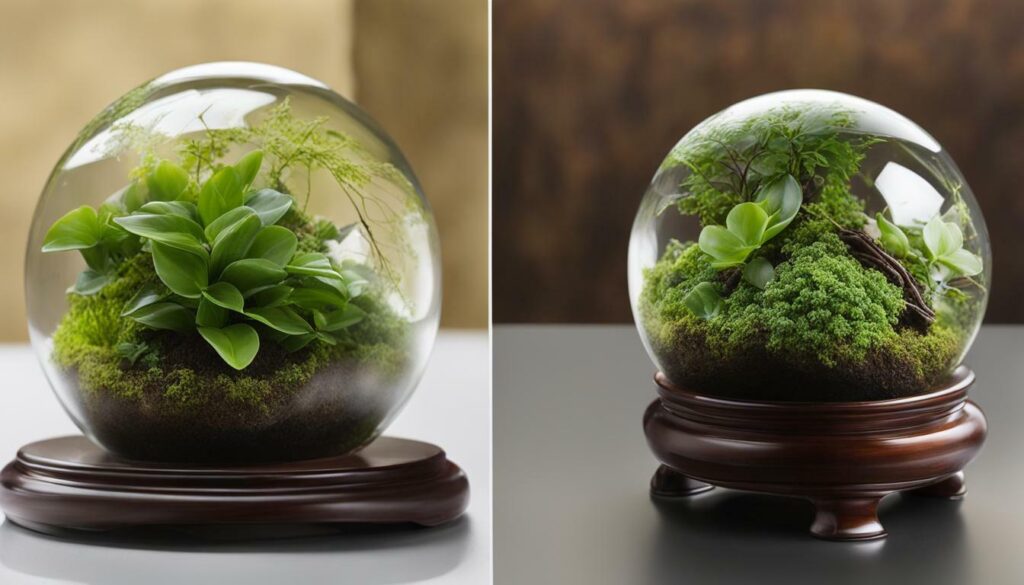
“Propagation allows you to create more creeping fig plants for your terrarium without the need for purchasing additional specimens. It’s an affordable and rewarding way to expand your collection.”
Dealing with Pests for Terrarium Plants: Creeping Fig
Unfortunately, even terrarium plants like the creeping fig aren’t immune to pests. These unwanted invaders can wreak havoc on your indoor oasis if left unchecked. But fear not! With a little knowledge and proactive measures, you can effectively treat and prevent pest infestations in your terrarium.
One common pest that affects creeping fig is aphids. These tiny insects feed on the plant’s sap, causing stunted growth and yellowing leaves. To combat aphids, you can try spraying the plant with a mixture of water and mild dish soap. Alternatively, you can introduce natural predators like ladybugs, which feed on aphids.
Another notorious pest is the mealybug. These soft-bodied insects are covered in a white, powdery substance and can quickly multiply, sucking the life out of your creeping fig. To get rid of mealybugs, you can use cotton swabs dipped in rubbing alcohol to remove them manually. Neem oil is also effective in controlling these pests.
Scale insects are another common nuisance for terrarium plants like the creeping fig. These small, immobile pests attach themselves to the plant’s stems and leaves, sucking out sap and causing yellowing and leaf drop. To eliminate scale, you can use a soft brush or cotton swab dipped in rubbing alcohol to remove them. In severe cases, systemic insecticides may be necessary.
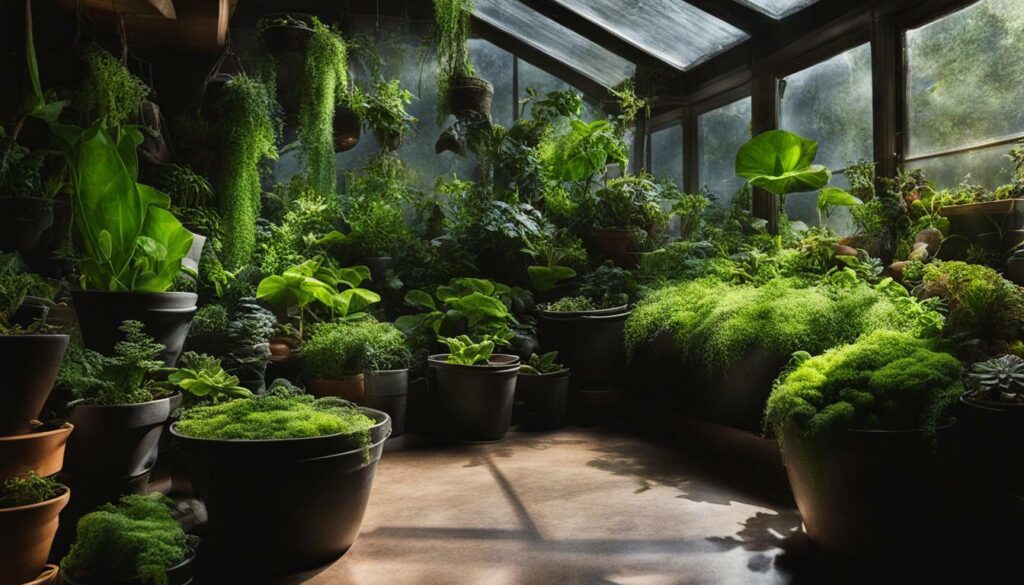
Whiteflies are yet another bothersome pest that can infest your creeping fig. These tiny, white insects fly around the plant and lay their eggs on the undersides of the leaves. When the eggs hatch, the larvae will feed on the foliage, leading to wilting and leaf drop. To control whiteflies, you can use yellow sticky traps or introduce natural predators like parasitic wasps.
Remember, prevention is key when it comes to pests in your terrarium. Regularly inspect your creeping fig for signs of infestation, such as discolored leaves or sticky residue. Quarantine any new plants before adding them to your terrarium, as they may carry pests. And finally, maintain a clean and healthy environment by regularly cleaning the terrarium and removing any dead leaves or debris.
| Common Pests | Treatment |
|---|---|
| Aphids | – Spray with water and mild dish soap – Introduce natural predators like ladybugs |
| Mealybugs | – Remove manually with cotton swabs dipped in rubbing alcohol – Use neem oil |
| Scale | – Remove with soft brush or cotton swab dipped in rubbing alcohol – Consider systemic insecticides for severe infestations |
| Whiteflies | – Use yellow sticky traps – Introduce natural predators like parasitic wasps |
Repotting Terrarium Plants: Creeping Fig
As your creeping fig thrives and outgrows its current pot, you’ll need to consider repotting to provide it with the ideal growing conditions—especially if you have a tropical or hanging terrarium. Repotting allows the roots to have more space to grow and access fresh nutrients, ensuring the plant remains healthy and vibrant.
Before repotting, carefully remove the creeping fig from its current container, taking care not to damage the delicate vines. Gently loosen the root ball and inspect the roots for any signs of damage or rot. Trim away any unhealthy roots with clean shears to promote optimal root health.
Choose a new pot that is slightly larger than the current one, ensuring it has drainage holes to prevent waterlogging. Fill the new pot with a well-draining potting mix, such as a blend of peat moss, perlite, and sand. Create a small hole in the center of the potting mix and carefully place the creeping fig into the hole, ensuring the root ball is covered with soil.
After repotting, water the creeping fig thoroughly to help settle the soil and provide hydration to the roots. Place the plant in a location with bright, indirect light to allow for optimal growth. Monitor the plant closely in the following weeks, adjusting its care routine as needed to ensure it adjusts well to its new container.
| Materials needed: | Steps: |
|---|---|
| – New pot with drainage holes | 1. Carefully remove the creeping fig from its current pot, inspecting the roots for damage. 2. Trim away any unhealthy roots. 3. Choose a new pot slightly larger than the current one and fill it with a well-draining potting mix. 4. Place the creeping fig in the new pot, ensuring the root ball is covered with soil. 5. Water the plant thoroughly after repotting. 6. Place the plant in a location with bright, indirect light. |
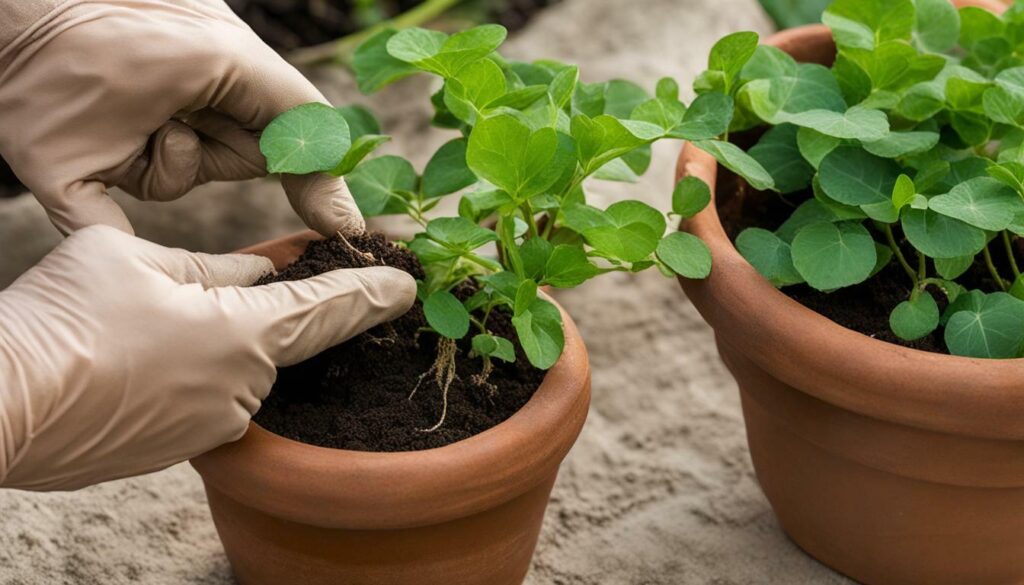
- Repot your creeping fig annually to ensure it has enough space to grow.
- Choose a pot that is only slightly larger than the current one to avoid excessive soil moisture.
- Use a well-draining potting mix to prevent waterlogging and root rot.
- Water the plant thoroughly after repotting, but be careful not to overwater it.
- Place the creeping fig in a location with bright, indirect light to support healthy growth.
Remember, repotting your creeping fig is an essential part of its care routine, allowing it to continue flourishing in your terrarium. By providing the plant with fresh soil and adequate space, you’ll help it thrive and maintain its stunning appearance.
Conclusion
In conclusion, growing creeping fig in a terrarium can bring a touch of natural beauty to your indoor space, with its cascading foliage and easy care requirements making it an ideal choice for both beginners and experienced plant enthusiasts alike. Whether you’re looking to create a tropical oasis or simply enhance your home decor, this versatile plant is readily available for purchase and will undoubtedly add a stunning touch to your indoor terrarium.
Ficus pumila, commonly known as creeping fig, is a popular plant for terrariums and indoor pots. Native to Asia, this vining plant features small heart-shaped glossy leaves that gracefully cascade over the sides of a pot. With its ability to tolerate a variety of growing conditions, creeping fig is relatively hardy and only requires warm, humid air, bright indirect light, and regular watering.
Creeping fig can reach lengths of up to 15 feet and has the potential to become invasive if grown outdoors within its recognized hardiness range. To keep it in check, regular pruning is essential. The plant can be propagated through stem cuttings and should be repotted annually. Additionally, careful monitoring and prompt treatment are necessary to combat pests such as aphids, mealybugs, scale, and whitefly.
With its availability for purchase online and its suitability as an indoor terrarium plant, creeping fig is a beautiful addition to any space. Its stunning foliage and low maintenance requirements make it a perfect choice for those looking to add natural beauty to their indoor environments. So, why not consider bringing the charm of creeping fig into your home and enjoy the beauty it brings to your terrarium?
How Can I Care for Creeping Fig in My Terrarium Like Other Air Plants?
Caring for creeping fig in your terrarium, like other thriving terrarium plants and air plants, requires a few key steps. Make sure to provide proper humidity and regular misting, as well as adequate sunlight and occasional pruning to keep your creeping fig healthy and thriving in your terrarium.
FAQ
Is creeping fig suitable for terrariums and indoor pots?
Yes, creeping fig is a popular plant for terrariums and indoor pots due to its attractive appearance and easy care.
Where is creeping fig native to?
Creeping fig is native to Asia.
What are the characteristics of creeping fig?
Creeping fig is a vining plant with small heart-shaped glossy leaves that cascade over the sides of the pot.
What are the growing conditions for creeping fig?
Creeping fig requires warm, humid air, bright indirect light, and regular watering.
How long can creeping fig grow?
Creeping fig can grow up to 15 feet in length.
Can creeping fig become invasive if grown outdoors?
Yes, creeping fig has the potential to become invasive if grown outdoors in its recognized hardiness range.
How should creeping fig be pruned?
Creeping fig should be pruned regularly to keep it in check.
How can creeping fig be propagated?
Creeping fig can be propagated through stem cuttings.
What pests are common for creeping fig?
Creeping fig is susceptible to pests such as aphids, mealybugs, scale, and whitefly.
How often should creeping fig be repotted?
Creeping fig should be repotted annually.

